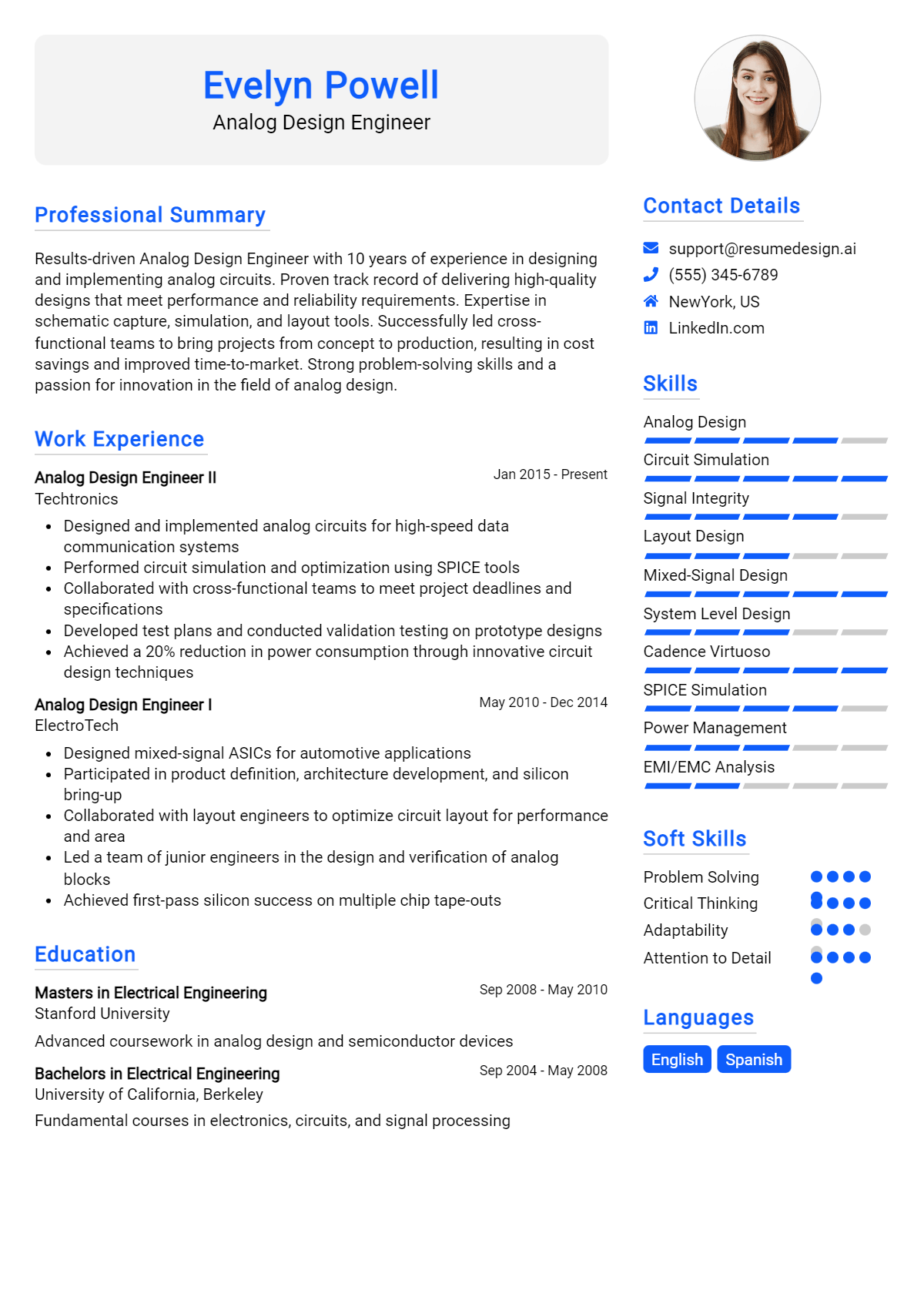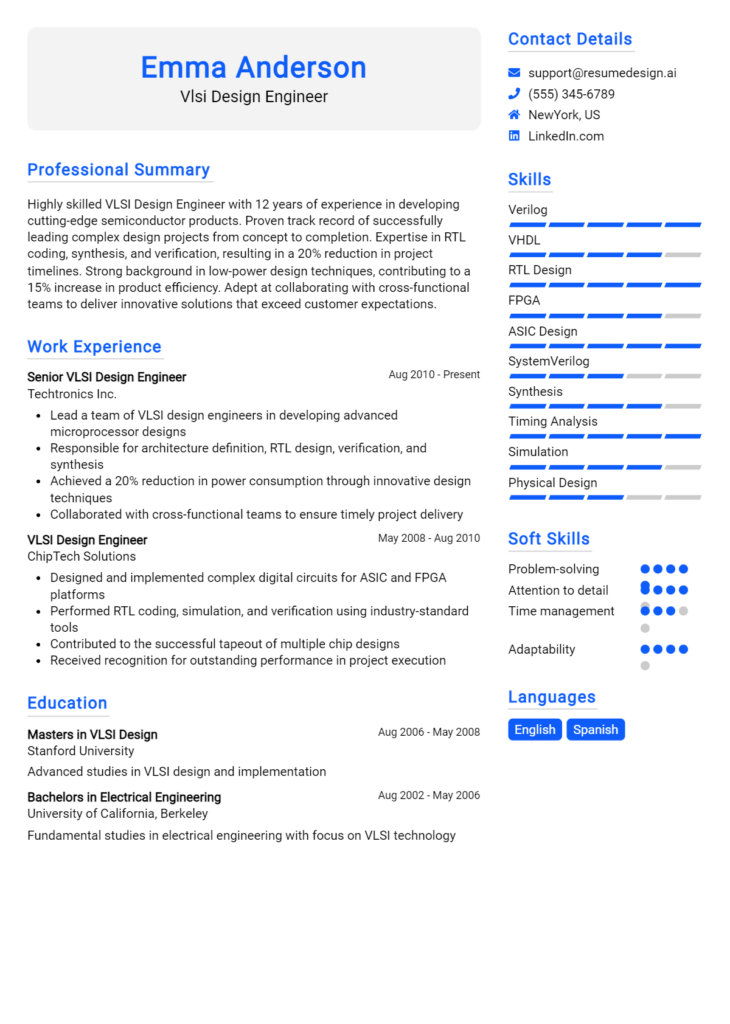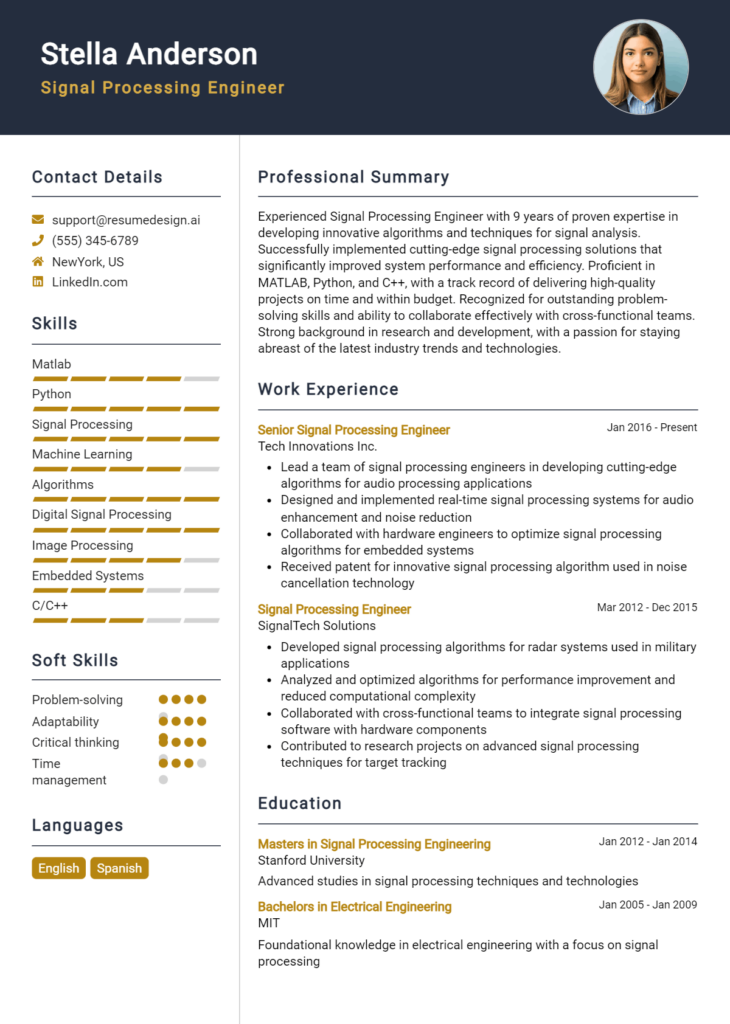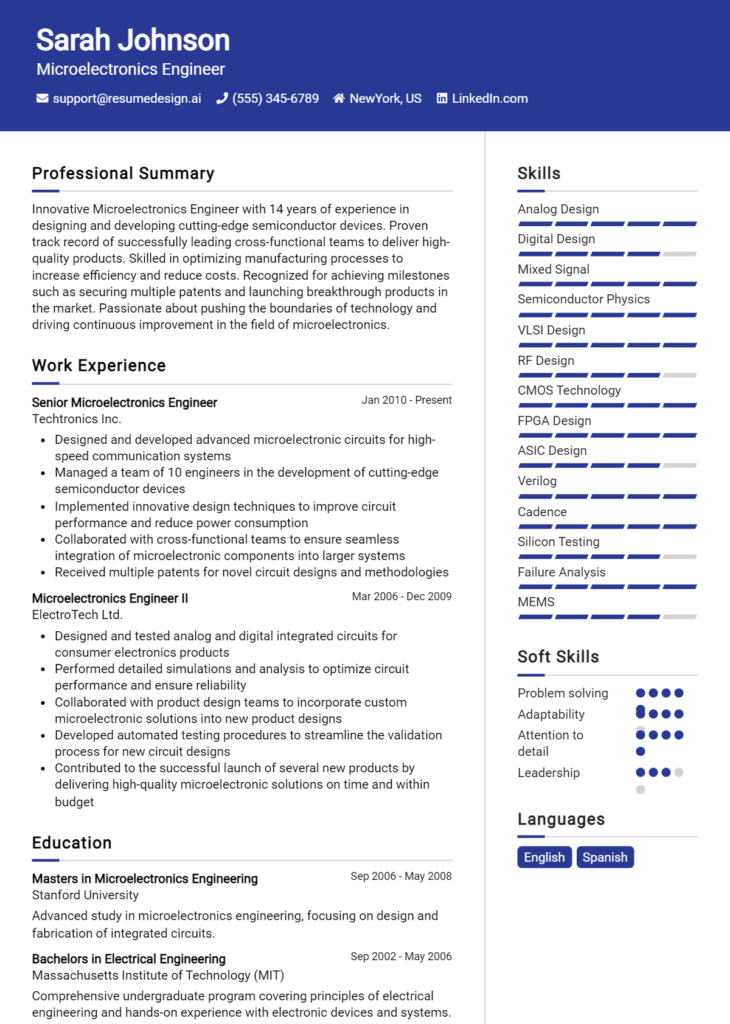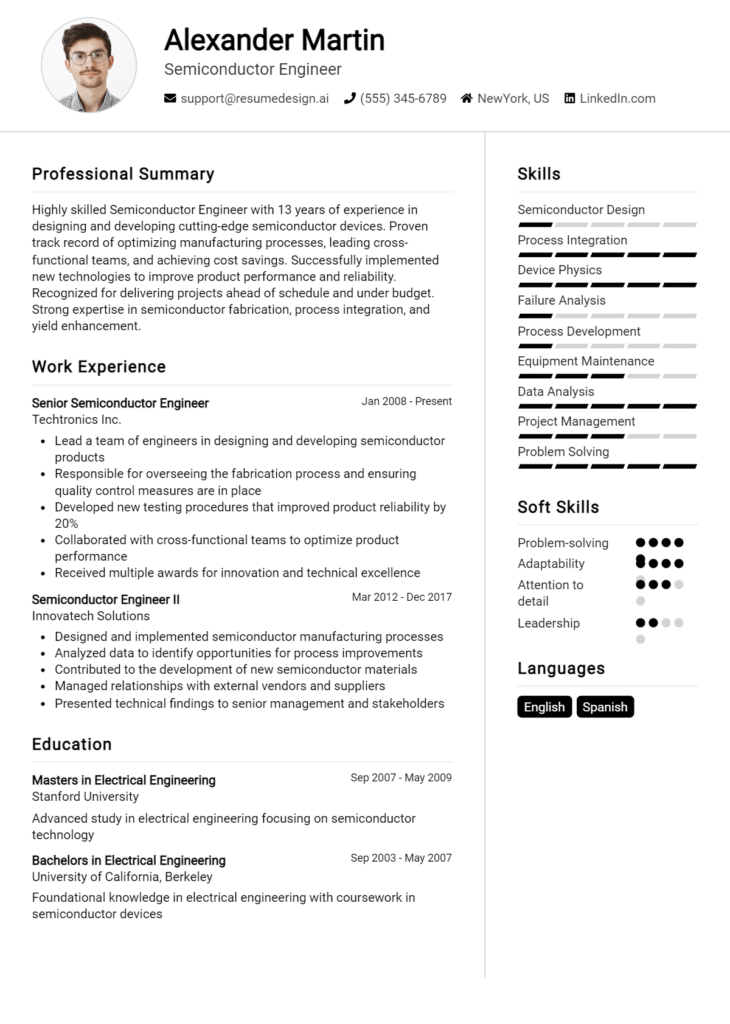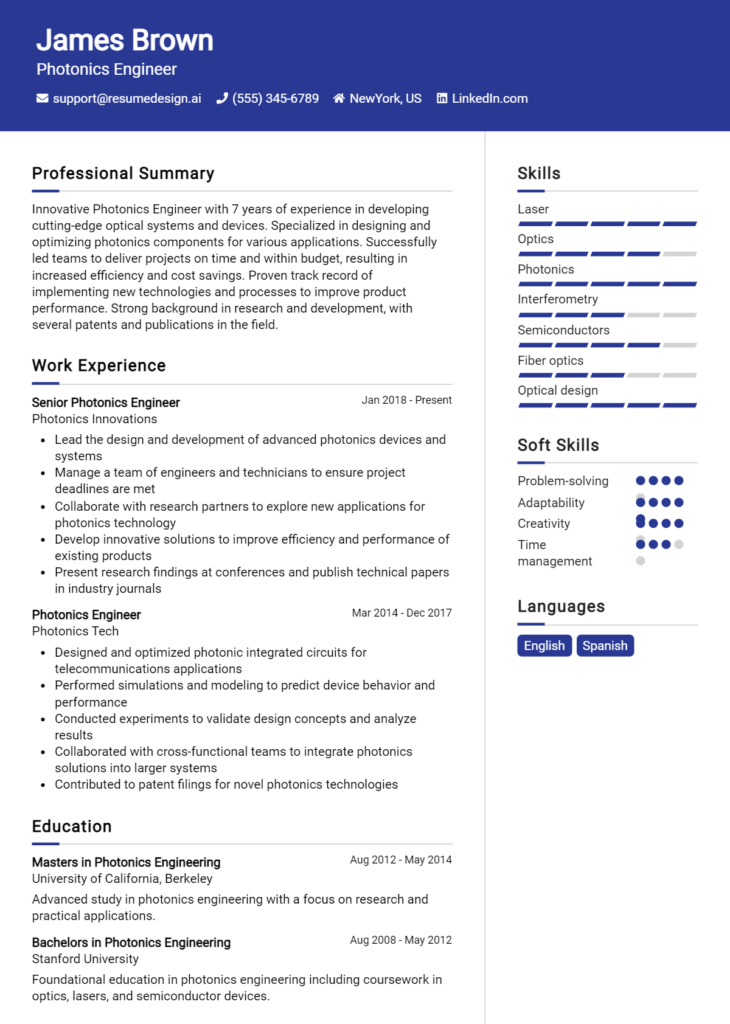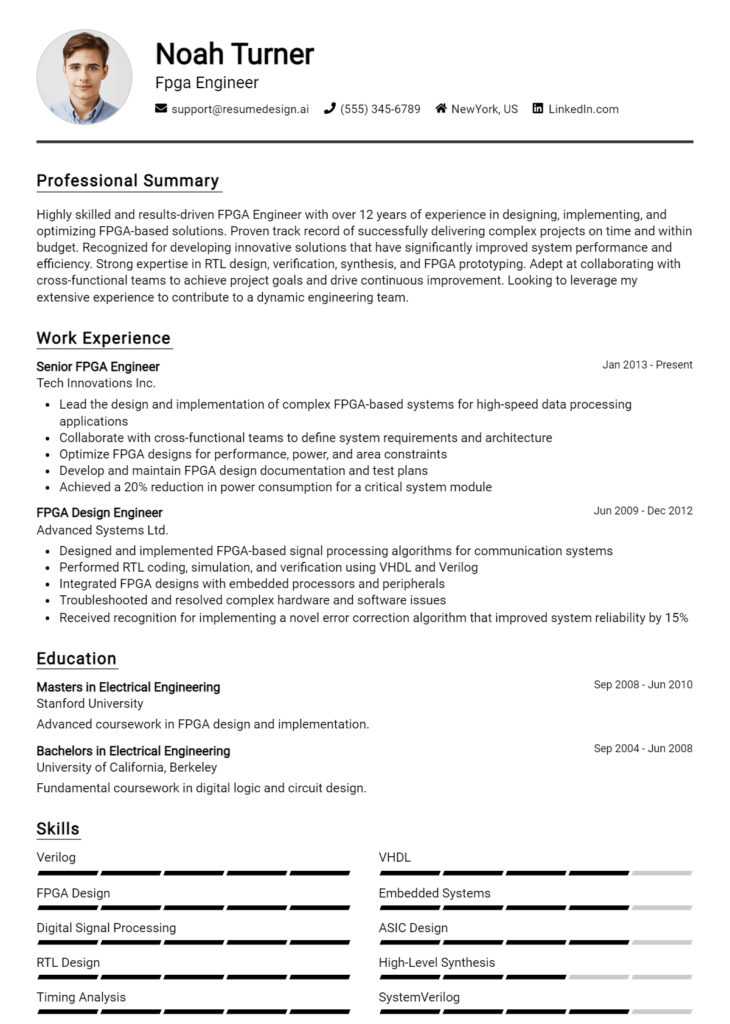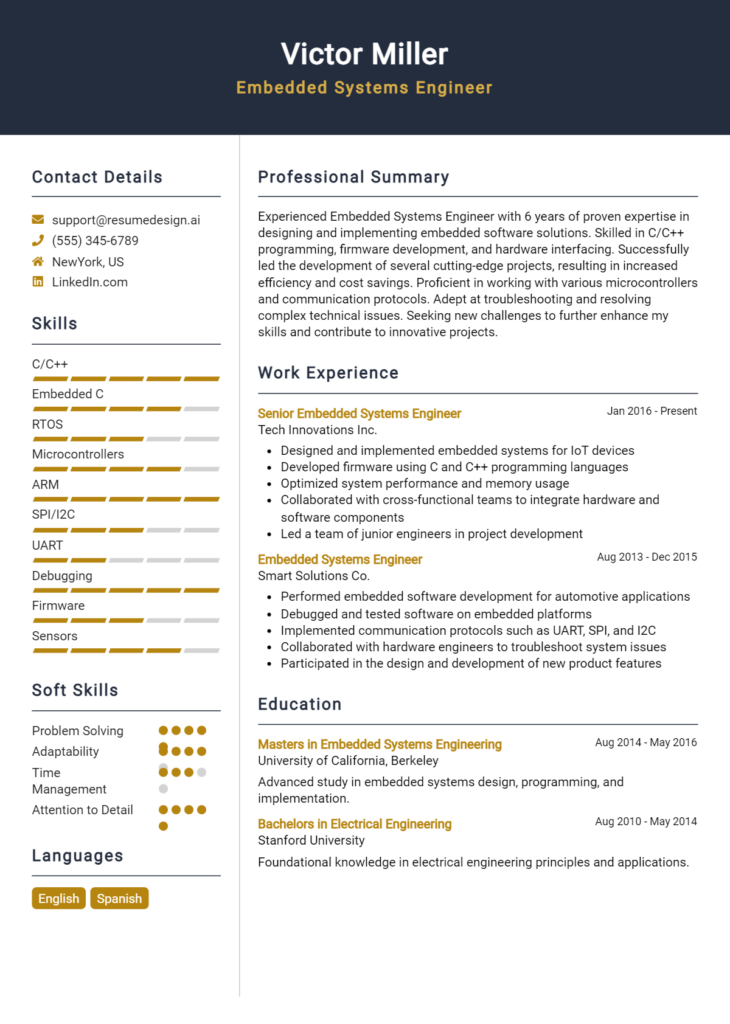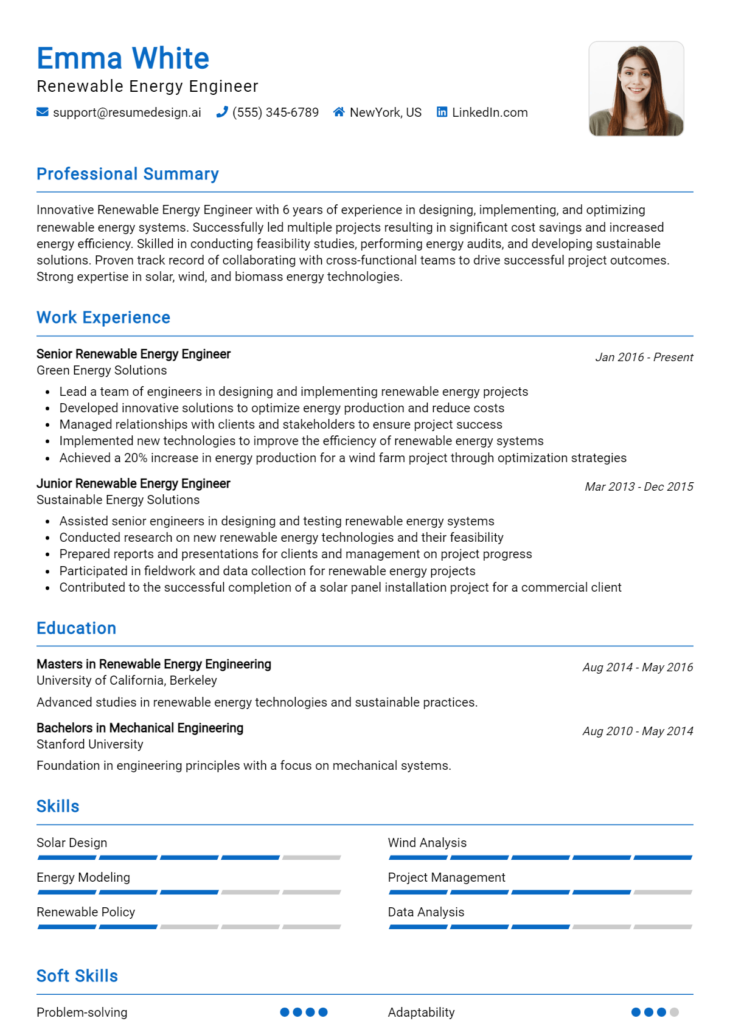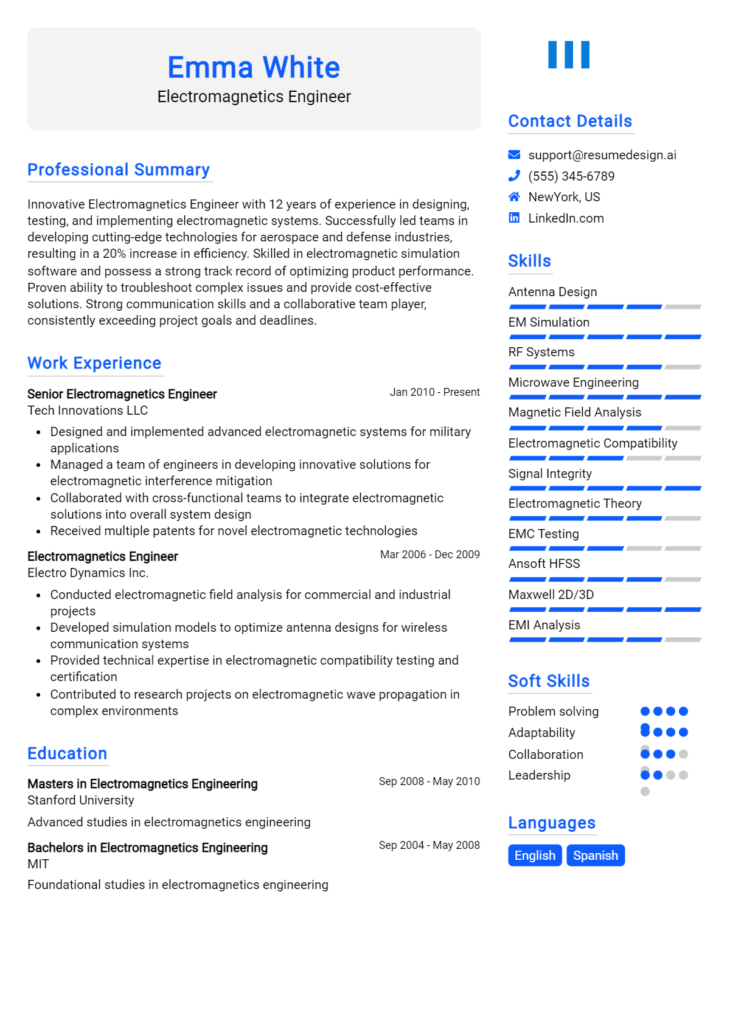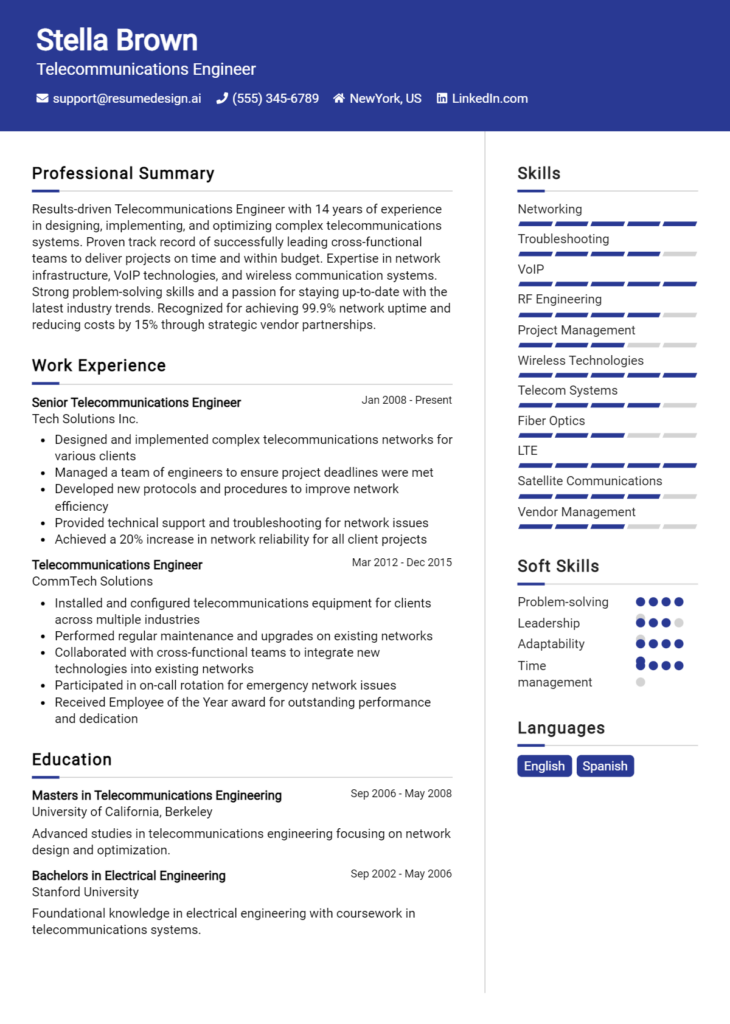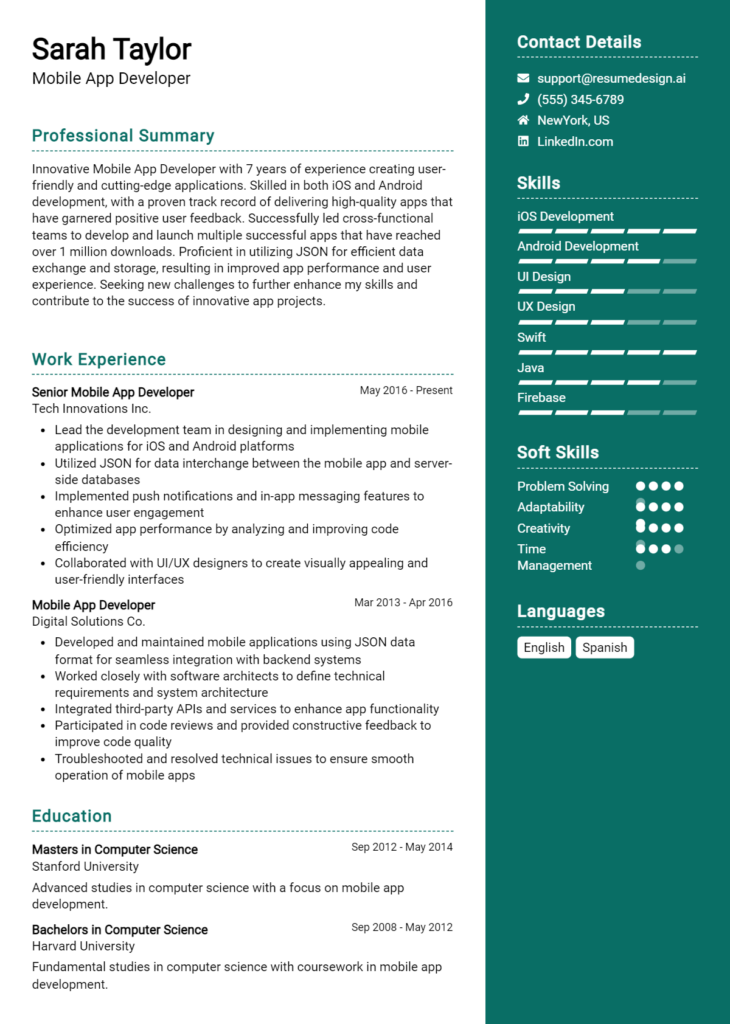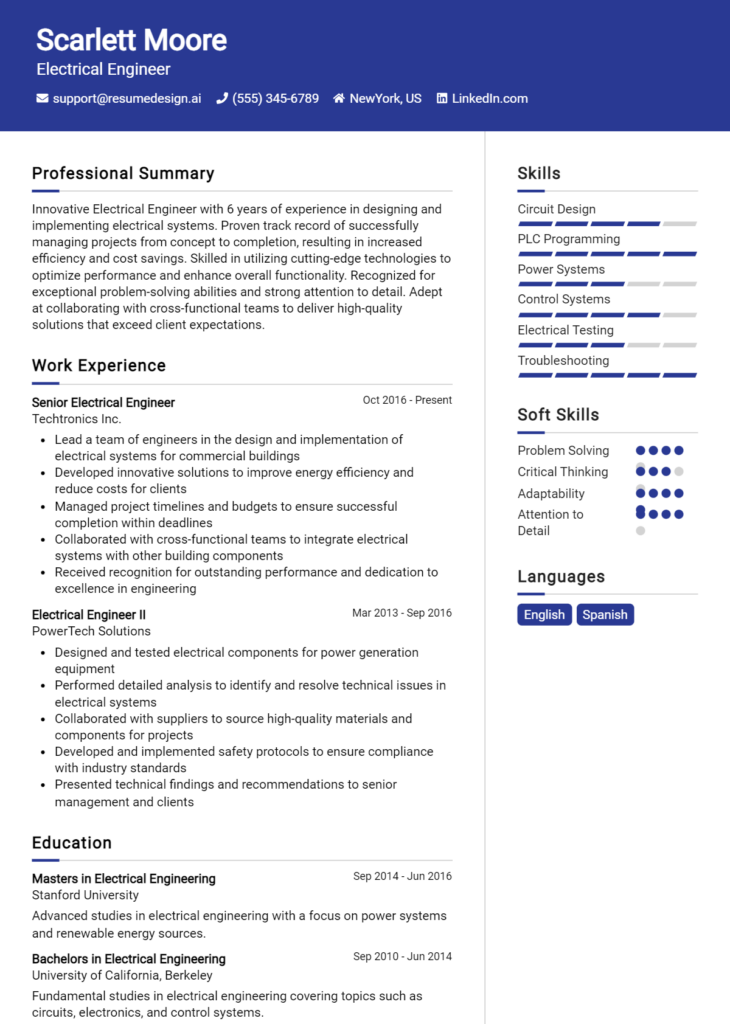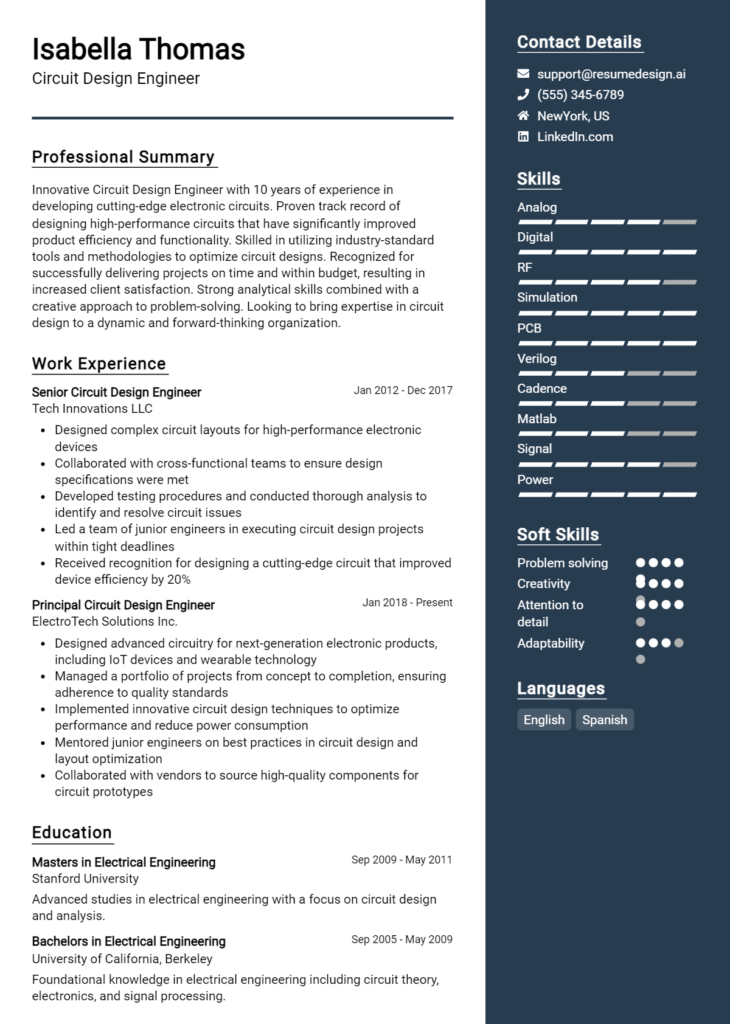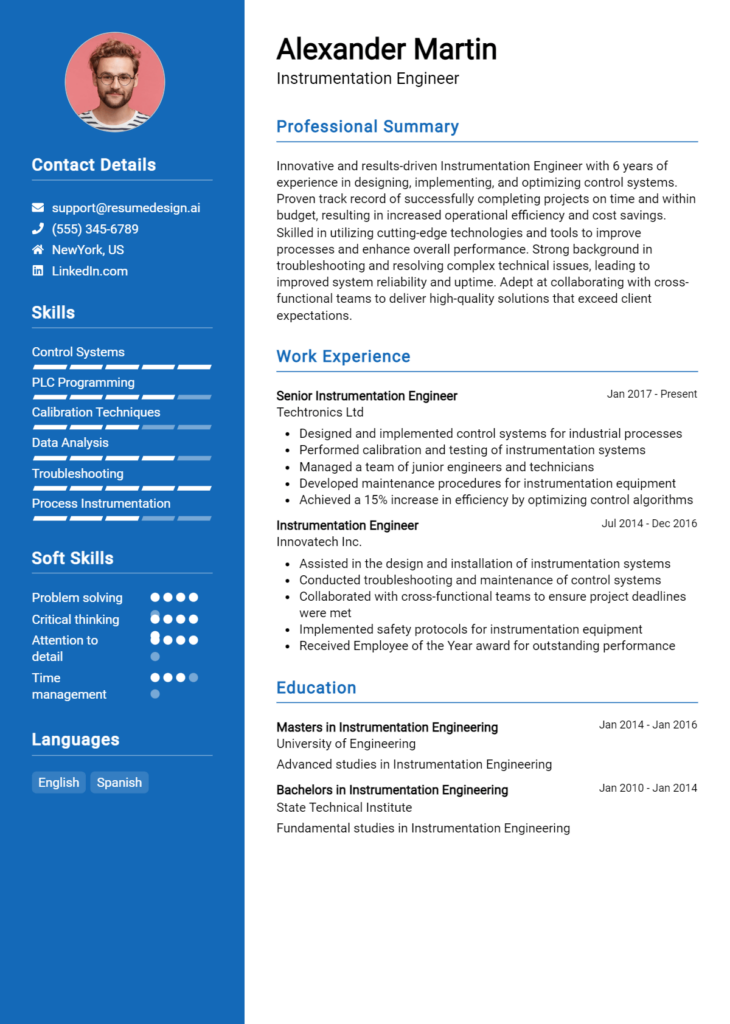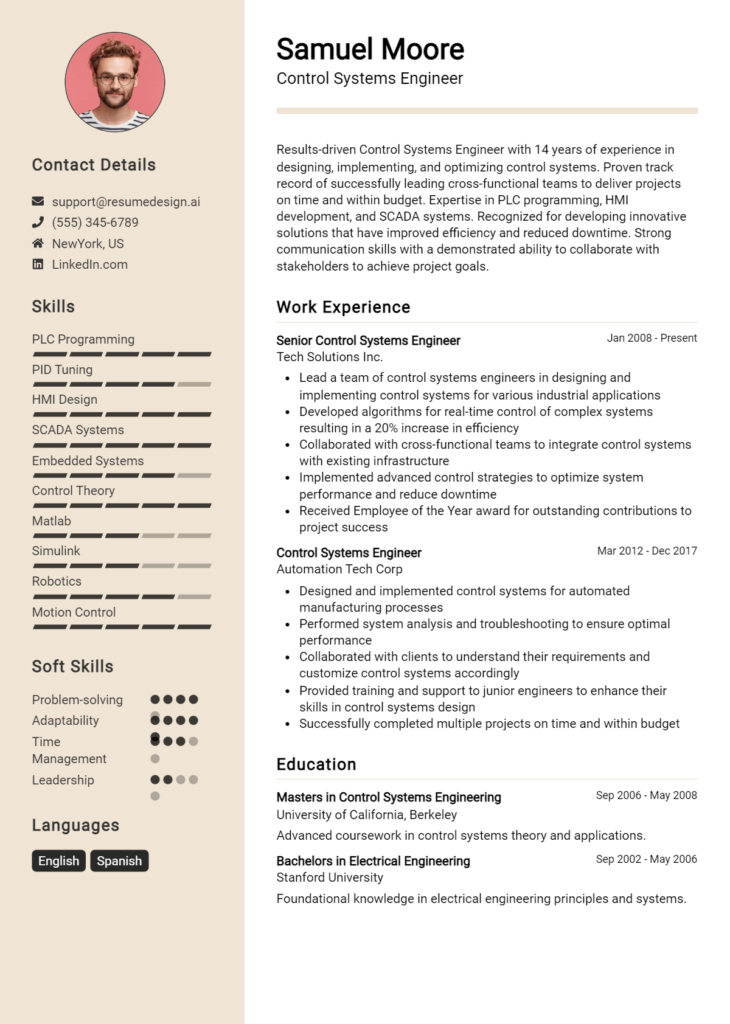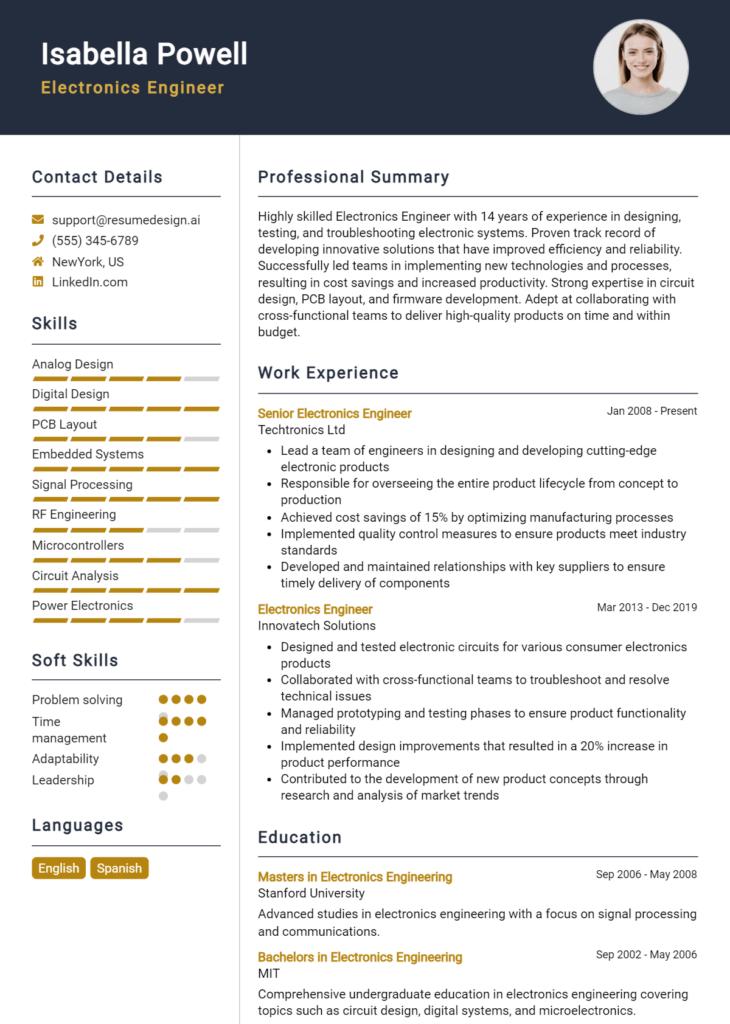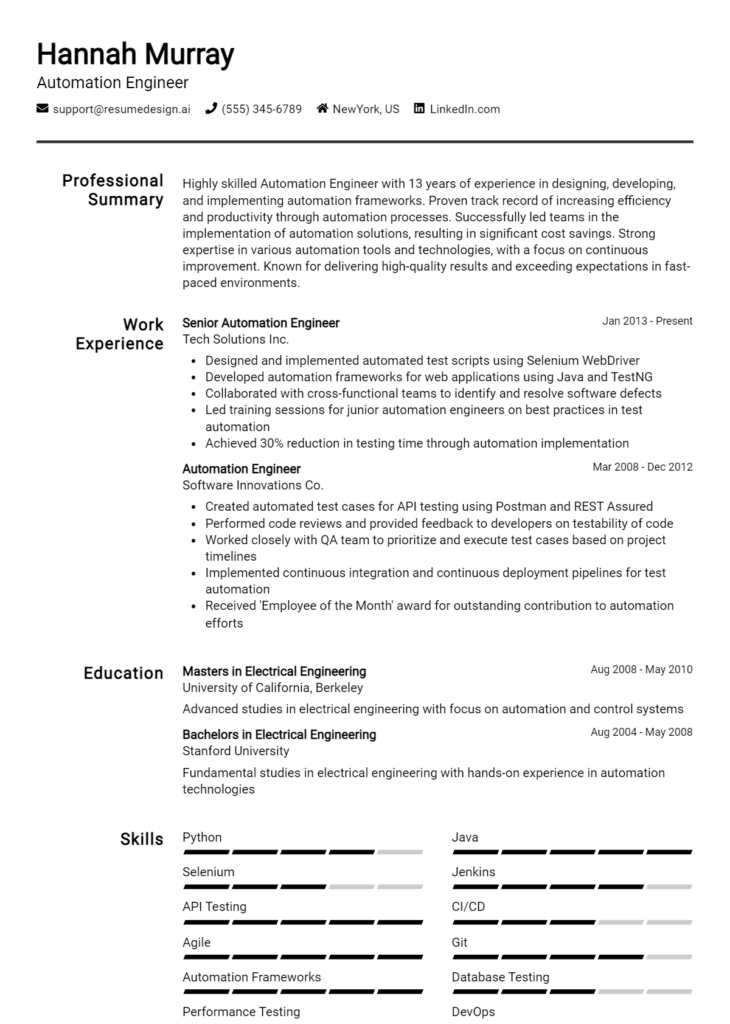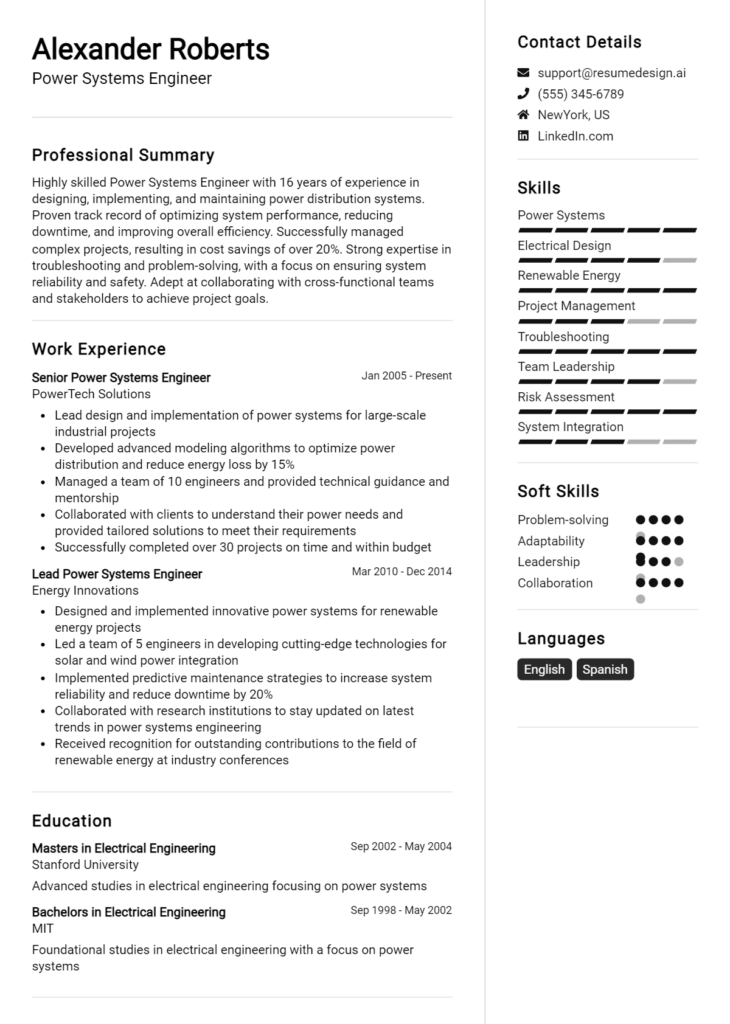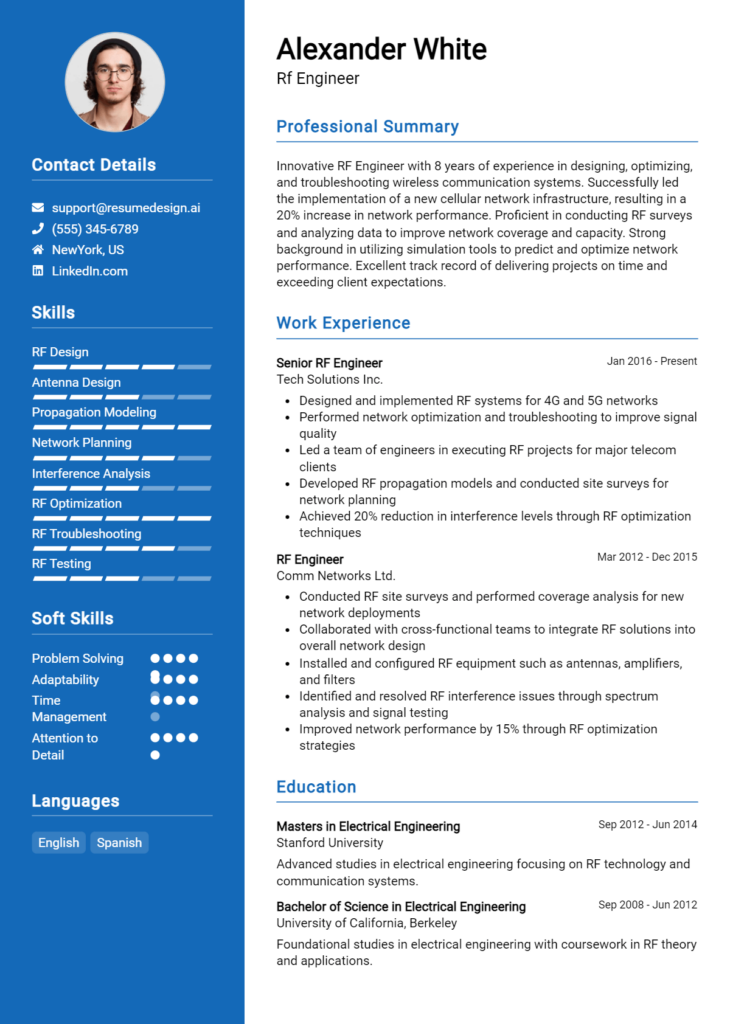Analog Design Engineer Core Responsibilities
An Analog Design Engineer is pivotal in creating and optimizing electronic circuits, requiring a blend of technical proficiency and innovative problem-solving skills. This role involves collaboration with cross-functional teams such as software, systems engineering, and manufacturing, ensuring designs meet operational requirements and performance goals. Proficiency in circuit simulation tools and an understanding of semiconductor physics are essential. A well-crafted resume highlighting these competencies demonstrates the candidate's value in driving organizational success.
Common Responsibilities Listed on Analog Design Engineer Resume
- Design and develop analog circuits for various applications.
- Conduct simulations and analyses to verify circuit performance.
- Collaborate with cross-functional teams to integrate analog designs with digital systems.
- Optimize existing designs for improved performance and efficiency.
- Conduct testing and validation of prototypes.
- Document design specifications and technical reports.
- Troubleshoot and resolve circuit design issues.
- Keep abreast of industry trends and emerging technologies.
- Participate in design reviews and feedback sessions.
- Ensure compliance with industry standards and regulations.
- Mentor junior engineers and interns in analog design principles.
High-Level Resume Tips for Analog Design Engineer Professionals
In today's competitive job market, a well-crafted resume is crucial for Analog Design Engineer professionals seeking to stand out to potential employers. Your resume serves as your first impression, often determining whether you advance to the interview stage or remain overlooked. It needs to effectively showcase not only your technical skills but also your significant achievements in the field of analog design. This guide will provide practical and actionable resume tips specifically tailored for Analog Design Engineer professionals, ensuring that your resume reflects your best self and resonates with hiring managers.
Top Resume Tips for Analog Design Engineer Professionals
- Tailor your resume for each job application by aligning your skills and experiences with the specific job description.
- Highlight relevant experience in analog design, including specific projects or roles that demonstrate your expertise.
- Quantify your achievements where possible, such as improvements in circuit performance or efficiency, to provide concrete evidence of your contributions.
- Showcase your familiarity with industry-standard tools and software, such as SPICE, Cadence, or MATLAB, to highlight your technical proficiency.
- Include any relevant certifications or licenses that can enhance your credibility as an analog design engineer.
- Demonstrate your problem-solving skills by describing specific challenges you've faced in previous roles and how you overcame them.
- Use clear and concise language, avoiding jargon that may not be understood by all hiring managers, to ensure your resume is accessible.
- Incorporate keywords from the job posting to help your resume pass through applicant tracking systems (ATS) and get noticed by recruiters.
- Maintain a clean, organized format with logical sections, making it easy for employers to navigate and locate key information.
By implementing these tips, you can significantly increase your chances of landing a job in the Analog Design Engineer field. A strong, focused resume that effectively highlights your skills, experiences, and accomplishments will not only capture the attention of hiring managers but also set you apart from other candidates vying for the same position.
Why Resume Headlines & Titles are Important for Analog Design Engineer
In the competitive field of analog design engineering, a standout resume title or headline is crucial for making a memorable first impression. A well-crafted headline serves as a powerful summary of a candidate's key qualifications, encapsulating their expertise and experience in a single, impactful phrase. This concise statement not only grabs the attention of hiring managers but also communicates the applicant's relevance to the specific role they are applying for. By effectively highlighting the most pertinent skills and accomplishments, a strong resume headline can set the stage for a compelling application that resonates with potential employers.
Best Practices for Crafting Resume Headlines for Analog Design Engineer
- Keep it concise: Aim for one impactful sentence that summarizes your qualifications.
- Be role-specific: Tailor your headline to match the specific position you are applying for.
- Highlight key strengths: Focus on your most valuable skills and accomplishments relevant to analog design engineering.
- Use industry keywords: Incorporate terminology that resonates within the analog design field to enhance searchability.
- Showcase results: If possible, include metrics or achievements that demonstrate your impact in previous roles.
- Avoid clichés: Steer clear of overused phrases that do not add value to your headline.
- Be authentic: Ensure your headline reflects your unique expertise and personality as an engineer.
- Revise and refine: Continuously improve your headline to keep it fresh and relevant to current trends in the industry.
Example Resume Headlines for Analog Design Engineer
Strong Resume Headlines
"Innovative Analog Design Engineer with 10+ Years of Experience in High-Frequency Circuit Design"
“Proficient in Mixed-Signal Design with Proven Track Record in Product Development and Reliability Testing”
“Results-Driven Analog Engineer Specializing in Low-Power Solutions for Consumer Electronics”
Weak Resume Headlines
“Engineer Looking for a Job”
“Experienced Professional”
The strong resume headlines are effective because they are specific, highlight relevant experience, and showcase key strengths that align with the needs of hiring managers in the analog design engineering field. They provide a clear, immediate understanding of what the candidate brings to the table. In contrast, the weak headlines fail to impress because they lack specificity and do not convey any particular skills or accomplishments, making it difficult for employers to see the candidate's unique value.
Writing an Exceptional Analog Design Engineer Resume Summary
A well-crafted resume summary is crucial for an Analog Design Engineer as it serves as the first impression for hiring managers. A strong summary succinctly highlights the candidate's key skills, relevant experience, and notable accomplishments, effectively summarizing their qualifications in a way that captures attention. In a competitive job market, a concise and impactful summary tailored to the specific job description can differentiate a candidate from others, setting the stage for the rest of the resume.
Best Practices for Writing a Analog Design Engineer Resume Summary
- Quantify Achievements: Use numbers and metrics to demonstrate the impact of your work, such as performance improvements or cost savings.
- Focus on Relevant Skills: Highlight skills that are directly applicable to the role, such as circuit design, simulation tools, and troubleshooting techniques.
- Tailor for the Job Description: Customize your summary to align with the specific requirements and keywords of the job you are applying for.
- Keep it Concise: Aim for 3-5 sentences that deliver essential information without unnecessary detail.
- Showcase Industry Experience: Mention years of experience and relevant industries to establish credibility.
- Use Action Verbs: Start sentences with strong action verbs to convey a sense of proactivity and results-driven nature.
- Highlight Soft Skills: Include interpersonal skills that are valuable in team settings, such as communication and collaboration.
- Maintain Professional Tone: Ensure the language is professional and free from jargon that may not be understood by all readers.
Example Analog Design Engineer Resume Summaries
Strong Resume Summaries
Results-oriented Analog Design Engineer with over 7 years of experience in developing high-performance RF circuits, achieving a 30% increase in efficiency in recent projects. Proficient in Cadence and SPICE simulations, with a proven track record of on-time project deliveries.
Detail-driven Analog Design Engineer with expertise in mixed-signal design and a history of reducing production costs by up to 15% through innovative design solutions. Adept at collaborating with cross-functional teams to enhance product performance.
Dynamic Analog Design Engineer with a strong foundation in semiconductor technology and a successful history of designing low-noise amplifiers that improved signal integrity by 25%. Skilled in using advanced testing equipment to validate designs.
Weak Resume Summaries
Experienced engineer looking for a position in analog design. I have worked on various projects and have a good understanding of circuits.
Analog Design Engineer with knowledge in the field. I aim to contribute to a team and enhance my skills further.
The strong resume summaries are effective because they provide specific examples of achievements and skills, clearly demonstrating the candidate's value to potential employers. They quantify results and describe relevant experiences, making it easier for hiring managers to see the candidate's qualifications at a glance. In contrast, the weak summaries lack detail and specificity, making them generic and unmemorable, which can hinder a candidate's chances of standing out in a competitive job market.
Work Experience Section for Analog Design Engineer Resume
The work experience section of an Analog Design Engineer resume is a critical component that highlights a candidate's technical skills and practical application in the field. This section not only showcases the individual's ability to design, implement, and troubleshoot complex analog systems, but it also reflects their capacity to lead teams and deliver high-quality products within stringent deadlines. By quantifying achievements and aligning experiences with industry standards, candidates can demonstrate their impact on previous projects and their readiness to contribute to future roles in the industry.
Best Practices for Analog Design Engineer Work Experience
- Detail specific projects that illustrate your technical expertise in analog design and circuit analysis.
- Quantify achievements with metrics, such as reduced power consumption, improved signal integrity, or cost savings.
- Highlight leadership roles and team management experiences, emphasizing your ability to guide and mentor colleagues.
- Use clear and concise language to describe your responsibilities and contributions in each position.
- Align your experiences with industry standards and emerging technologies to show relevance and adaptability.
- Include collaborative projects that demonstrate your ability to work with cross-functional teams.
- Showcase any patents, publications, or presentations related to your work in analog design.
- Tailor your work experience to the specific job description, emphasizing skills and achievements that match the employer's needs.
Example Work Experiences for Analog Design Engineer
Strong Experiences
- Led a team of engineers in the design and implementation of a low-noise amplifier, achieving a 30% reduction in power consumption while maintaining signal integrity across various frequencies.
- Developed a mixed-signal circuit that improved the overall system performance by 25%, resulting in a 15% increase in customer satisfaction ratings.
- Managed a cross-functional team to complete a high-stakes project under budget and three weeks ahead of schedule, earning recognition from senior management for exceptional project execution.
Weak Experiences
- Worked on various projects related to analog design.
- Responsible for team collaboration and project management.
- Helped improve circuit designs.
The examples provided illustrate the distinction between strong and weak work experiences. Strong experiences are specific, quantifiable, and demonstrate clear leadership and collaboration, reflecting the candidate's direct impact on projects. In contrast, weak experiences lack detail, are vague about contributions, and do not provide measurable outcomes, which diminishes their effectiveness in showcasing the candidate's qualifications for an Analog Design Engineer role.
Education and Certifications Section for Analog Design Engineer Resume
The education and certifications section of an Analog Design Engineer resume plays a crucial role in showcasing the candidate's academic achievements and professional qualifications. This section not only highlights the foundational knowledge required for the role but also emphasizes the candidate's commitment to continuous learning through industry-relevant certifications and specialized training. By presenting relevant coursework, advanced degrees, and recognized credentials, candidates can significantly enhance their credibility and demonstrate their alignment with the demands of the analog design engineering field.
Best Practices for Analog Design Engineer Education and Certifications
- Include only relevant degrees and certifications that align with the job description.
- Highlight advanced degrees like a Master's or Ph.D. in Electrical Engineering or related fields.
- List industry-recognized certifications, such as Certified Analog Design Engineer (CADE) or similar credentials.
- Provide specific coursework that pertains directly to analog design, signal processing, or circuit design.
- Be concise yet detailed; include the institution, degree, and graduation year.
- Emphasize any specialized training or workshops that enhance your skills in analog design.
- Organize the section chronologically or by relevance to make it easily digestible.
- Update this section regularly to reflect any new qualifications or relevant training acquired.
Example Education and Certifications for Analog Design Engineer
Strong Examples
- M.S. in Electrical Engineering with a focus on Analog Circuit Design, University of California, Berkeley, 2021
- Certified Analog Design Engineer (CADE), Analog Devices, 2022
- Relevant Coursework: Advanced Analog Circuit Design, Signal Integrity, and RF Circuit Design
- B.S. in Electronics Engineering, Georgia Institute of Technology, 2019
Weak Examples
- B.A. in History, State University, 2018
- Certification in Basic Computer Skills, Online Institute, 2020
- Outdated degree in Electrical Engineering Technology, Technical College, 2015
- High School Diploma, Local High School, 2016
The strong examples are considered effective because they directly relate to the skills and knowledge required for an Analog Design Engineer, demonstrating advanced education and relevant certifications. In contrast, the weak examples lack relevance to the field of analog design engineering, featuring outdated or irrelevant qualifications that do not contribute to the candidate's expertise in the industry.
Top Skills & Keywords for Analog Design Engineer Resume
As an Analog Design Engineer, the importance of showcasing the right skills on your resume cannot be overstated. Employers seek candidates who not only possess technical expertise but also demonstrate strong interpersonal abilities. A well-crafted resume that highlights relevant skills can significantly enhance your chances of landing an interview. By focusing on both hard and soft skills, you can present a comprehensive picture of your capabilities, making you a more attractive candidate in a competitive job market. To learn more about how to effectively highlight your skills and work experience, follow the guidelines provided below.
Top Hard & Soft Skills for Analog Design Engineer
Hard Skills
- Circuit Design
- Signal Processing
- Analog Integrated Circuit Design
- PCB Design and Layout
- RF Design
- SPICE Simulation
- Voltage Regulators
- Op-Amp Design
- Noise Analysis
- System-on-Chip (SoC) Design
- Test and Measurement Techniques
- Semiconductor Physics
- Electronic Device Modeling
- Power Management IC Design
- Prototyping
- Design Verification
- DFM (Design for Manufacturability)
Soft Skills
- Problem-Solving
- Attention to Detail
- Team Collaboration
- Effective Communication
- Time Management
- Adaptability
- Creativity
- Critical Thinking
- Project Management
- Leadership
- Customer Focus
- Analytical Thinking
- Initiative
- Conflict Resolution
- Decision-Making
- Mentoring
- Networking
- Continuous Learning
Stand Out with a Winning Analog Design Engineer Cover Letter
I am writing to express my interest in the Analog Design Engineer position at [Company Name], as advertised on [Job Board/Company Website]. With a Master’s degree in Electrical Engineering and over [X years] of experience specializing in analog circuit design, I am excited about the opportunity to contribute to your team. My background in designing high-performance analog circuits for various applications, including RF systems and mixed-signal devices, aligns well with the innovative projects at [Company Name].
Throughout my career, I have developed a strong skill set in designing and optimizing analog circuits, including amplifiers, oscillators, and filters. At [Previous Company Name], I successfully led the design of a low-noise amplifier that improved signal integrity by 30%. My proficiency with industry-standard tools such as Cadence and SPICE, combined with my hands-on experience in lab testing and validation, has equipped me with the ability to take projects from concept to production efficiently. I pride myself on my collaborative approach, working closely with cross-functional teams to ensure that design specifications meet both performance and cost targets.
In addition to my technical expertise, I bring a passion for continuous learning and development in the rapidly evolving field of analog design. I actively engage in professional development opportunities, such as attending workshops and seminars, to stay updated on the latest trends and technologies. I am particularly impressed by [Company Name]'s commitment to innovation and sustainability, and I am eager to contribute my knowledge and skills to help drive your projects to success.
Thank you for considering my application. I look forward to the possibility of discussing how my background, skills, and enthusiasms align with the needs of your team at [Company Name]. I am excited about the potential to contribute to your groundbreaking work and would be honored to be a part of such a dynamic organization.
Common Mistakes to Avoid in a Analog Design Engineer Resume
When crafting a resume for an Analog Design Engineer position, it's essential to present your skills and experiences effectively. Many candidates fall into common traps that can undermine their chances of landing an interview. Understanding these mistakes can help you refine your resume and showcase your qualifications more effectively. Below are some prevalent errors to avoid:
Lack of Specificity: Failing to include specific details about projects or technologies you've worked with can make your experience seem vague. Clearly outline your contributions and the tools used.
Ignoring Keywords: Many companies use applicant tracking systems (ATS) to filter resumes. Not incorporating relevant keywords from the job description can lead to your resume being overlooked.
Overloading with Technical Jargon: While technical skills are crucial, using excessive jargon can alienate non-technical reviewers. Balance your technical language with clear descriptions of your work.
Neglecting Soft Skills: Focusing solely on technical abilities can be detrimental. Highlighting soft skills such as teamwork, communication, and problem-solving is equally important in engineering roles.
Inconsistent Formatting: A cluttered or inconsistent format can distract from the content of your resume. Maintain uniformity in font, sizes, and bullet points to enhance readability.
Including Irrelevant Experience: Listing unrelated work experiences can dilute the impact of your resume. Stick to relevant roles that showcase your skills in analog design.
Omitting Quantifiable Achievements: Failing to mention measurable outcomes of your work can make your contributions seem less impactful. Use metrics to demonstrate your successes, such as improved performance or cost savings.
Not Tailoring for Each Application: Sending out a generic resume can be a missed opportunity. Customize your resume for each application to better match the specific requirements and responsibilities of the role.
Conclusion
As we explored the role of an Analog Design Engineer, we highlighted the essential skills, educational background, and experiences that contribute to success in this field. Key points included the importance of proficiency in circuit design, familiarity with simulation tools, and the ability to work collaboratively in a team environment. Additionally, we discussed the evolving landscape of analog design and the need for continuous learning to keep up with technological advancements.
In conclusion, if you're seeking to advance your career as an Analog Design Engineer, it's crucial to ensure that your resume effectively showcases your skills and experiences. Take the time to review your resume and consider utilizing the various resources available to enhance it. Tools such as resume templates, a resume builder, and resume examples can help you craft a standout resume. Additionally, don’t overlook the importance of a tailored cover letter, which you can create using our cover letter templates. Start refining your resume today to ensure you make a strong impression in the competitive job market!

